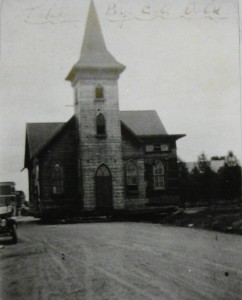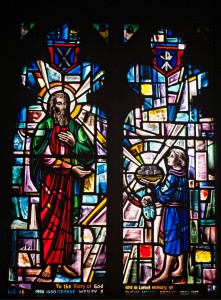In the beginning

The history of St. Andrew’s Presbyterian Church begins long before the erection of the magnificent building that stands today and has attained status as a designated heritage site. The congregation traces its history back to 1869 when Presbyterian services were first held in Fort William, a Hudson Bay fort on the banks of the Kaministiquia River.

Old St. Andrew’s Presbyterian makes way for new building
In 1889, the first St. Andrew’s Presbyterian Church was built and remained on the current site for over twenty years. By 1909 the congregation had outgrown the small church, so the church council decided to construct a new building. On July 19th, 1913, old St. Andrew’s Presbyterian Church was lowered onto rollers and moved to Pruden St. to become what is now Knox United Church.
New St. Andrew’s construction supported by generous donations of land, materials and funding
The McKellar family donated the land for the church to the Presbyterian Church. Peter McKellar was a member of the building committee and was responsible for laying the foundation stone, which comes from Mount McKay. Two McKellar sisters donated a stained glass window, depicting The Good Shepherd.
The cost of construction, although significant, was eased by the generous donations made by numerous members of the community. Mr. M. H. Braden, the contractor, contributed much of the sandstone for the building. Four hundred and forty subscribers pledged enough money to fund half of the cost of the structure, and the rest was borrowed from the Canada Life Assurance Co. and the Bank of Montreal. The Carnegie Foundation and the Ladies’ Guild pledged monies for the costly organ.
As thanks, Church offers array of public services
Apart from minor renovations, the church’s structure has remained unaltered. In thanking the community for their generous response to the undertaking, the Church promised the new structure would offer an array of public services, “in greater congregational endeavor and in fulfilling the responsibilities of Presbyterianism in this Imperial City of the Unsalted Seas.” To this day the congregation honours that promise, welcoming and serving the community.
A house hiding the south wall of St. Andrew’s Presbyterian Church was torn down, exposing the unsightly brick wall. In an effort to improve the appearance, local artist Mike O’Connor was hired to paint a stone mural overtop of the brick. The result is an authentic looking south wall consistent with the rest of the church.
St. Andrew’s Presbyterian Church, the “most imposing … in the city”
In a special meeting held on March 13th, 1907 the church council decided a new church building should be constructed, one that could seat between 800 – 1000 people. The two local architects designated for the project; Mr. William Hood and Mr. John Stinson, designed the church in the style of 14th century English Gothic. One of the most striking architectural features of the church is the massive tower at the northeast corner, which is reminiscent of the “historic towers in Scotland and is suggestive of the fact that the Presbyterian Church has a history behind it stretching back to the Reformation…”
Sandstone quarried on Simpson Island at mouth of Nipigon River
The first drafts for the structure called for a brick church, but after laying the foundation, Braden (the contractor), the building committee and the architects held a conference to discuss an alternate plan. For an additional four thousand dollars, the entire structure could be made from Simpson Islet grey/white sandstone. Fortunately, the members of the congregation willingly agreed to the supplementary cost. The resulting edifice was declared “magnificent,” “the most imposing…in the city,” which has “attracted much complimentary notice.”
Ten massive, polished granite columns support main entrance
Of special interest is the main entrance facing Brodie Street. It is composed of two Gothic arches with elaborate moulds and is supported at the centre and on either side by ten massive, polished granite columns. The ornamental cap of Bedford stone is beautifully carved, the design at the centre being the Maple Leaf, while the one on the right is carved into a Rose and on the left, the Scottish Thistle. The label mould around the arches stops with two bosses, carved with Shamrocks in bold relief, while on the right arch final is carved the Leek, representing Wales and on the left final are the Lilies of France. All these carvings are symbolic of the fact that everyone is welcome to the church.
The main tower of the north-east corner is also architecturally significant. It rises to a height of ninety-five feet and is supported by four angle buttresses. Square to the clock loft, it changes into an octagon and terminates in the well known typical Gothic weathering of this period of architecture.
Stained glass windows tell stories in glowing colour

Stained glass windows enhance the beauty of the church, depicting The Good Shepherd, the Dove with the Olive Branch, a Wheat Sheaf, the Burning Bush and St. Andrew’s Cross. These windows are effectively atmospheric for the interior of the church as well, which is constructed entirely of hardwood.
The interior design is simple; four spacious aisles separate the pews which are situated in a semi-circle. Massive oak staircases lead to the gallery and help to create the subdued tone which is in keeping with the religious character of the building.
Just the facts
The Architects: William Hood: Helping design St. Paul’s United, Brodie Street Resource Library and St. Andrew’s Presbyterian Church, William Hood was a well known and successful architect of his time. He was first a resident of Fort William, arriving in 1906 or 1907 and joining with John Stinson.
John C. Stinson: Listed as a contractor in 1899, Stinson made the shift to architect in 1903. The Fort William Times Journal mentions in an article written for the March 30th, 1907 edition: “J.C. Stinson … has probably designed the majority of the buildings in the City during the last few years…”
Year Built: 1909
Style: English Gothic
Notable Features: Simpson islet grey/white sandstone, Main entrance composed of two Gothic arches with elaborate moulds, Ninety-five foot north-east tower
Legal Description: Plan 123 Lot 47 to 48 W/S Brodie St.
Current Owner: St. Andrew’s Presbyterian Church
Date of Designation: Oct 23rd, 1984
